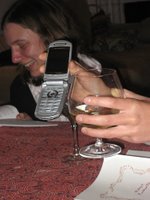Sheva Brachot
We had the honor of hosting sheva brachot for Kavitha and Eli last night. What a wonderful ritual. In the week after a couple is married, Jewish tradition provides a special addition to the end of the grace after meals. That extra bit is a set of seven blessings with their own tune and a powerful niggun which seperates them. I'll provide some more clear directions at the end in case anyone wants to use this terrific ritual.

We had a dozen people over for dinner, good friends of ours and the Stargods.

After dinner we commenced with the benching. six of the seven special brachot were led by folks sitting around the table. the fifth bracha was facilitated by a dear friend in Brookline with a little help from a satellite, a pair of cell towers, and lots of technology. Rob pointed out that it was too bad we didn't film the whole thing as we probably could have sold it to verizon.
Here is a pair of pictures of Eli and Kavitha actually drinking the wine from the Sheva Brachot:


As promised a quick primer on sheva brachot (suggestions very welcome):
1) invite people
to say the sheva brachot, traditionally you need a minyan. in progressive communities, make sure you have at least ten folks (generally yidden) one of whom was not at the wedding.
2) cook
it is often a good plan to take care of the main courses and see if friends will bring wine (make sure you have red+white), salad, dessert, etc.
3) motzei
you will need to say birkat hamazon (grace after meals) so make sure you say motzei.
4) Eat!
Eat, drink, relax, listen to stories about the wedding, tell stories about your friends who have just been married, and of course, have a good time.
5) Bench
This is the most complicated part as there are a few differences from normal benching.
- Before you start make sure you have two glasses of wine and an empty glass. for aesthetic reasons i recomend a full glass of white wine and a 1/4 glass of red wine so that when they are later combined it is a nice visual. Also, sometime before you start clarify which guests would like to lead which of the sheva brachot. All but the last one (borei pri hagafen) can be given out. Generally whoever leads benching says borei pri hagafen.
- The person who leads benching uses the red wine (though it doesn't have to be red i am going to call the glasses red and white, to keep them straight). hold the glass as you facilitate benching.
- In honor of the occasion you say shir hamalot. This page has eli singing several wedding related niggunim. the first one listed for od yishama is a common choice for a shir hamalot tune.
- Instead of the normal mizuman, there is a special one which starts with devai haser. the sheva brachot niggun, found here, fits nicely and foreshadows its use later. After doing the unusual mizuman you continue back to the normal benching.
- The benching proceeds as it normally does until the harachaman portion where a special harachaman is added for newlyweds.
- then things are back to normal through the end of benching. upon ending, switch to the sheva brachot niggun.
- the benching leader has been using the red wine glass.
- the white wine glass is passed to the person honored with saying the first blessing.
- the white wine glass is passed to the people saying blessings 2-6.
- blessings 5 and 6 have musical pieces. Anyone have any online recordings of these?
- after blessing 6 pass the white wine to the benching leader.
- the leader now says the 7th blessing over the RED wine.
- then combine the glasses into the third glass. The reason for using much less red wine than white wine is so that when you pour them toghether, they turn a shade of pink. if you use even vaguely as much red wine as white, it will just turn the resulting solution into a dark red colored liquid.
- After the glasses have been combined pass them on your recently married friends.
- After they drink they generally pass around the cup to the others present. it is an honor to get to drink from the cup.
- After combining the two cups of wine, some folks pour the mixed wine back in to the (now empty) two wine glasses so that there will be one for the guests of honor and another for the benching leader. however, if the married folks pass their glass around after they get their sip on, it is unecessary to pour a separate glass for the benching leader.


3 Comments:
There is no need to use red and white wine. If you prefer you can use the same wine for both cups. Also, some people prefer to use full cups of wine.
After mixing the 2 cups into the 3rd you will see people pour back into the original cup. That way you have a cup for the person who said borei p'ri hagafen to drink from.
1) most American brides & grooms are very honeymoon/trip-by-themselves focused. This is at odds with the wonderful ritual of sheva brachot, which presumes staying home in your community of friends & family. I guess honeymoons are a modern marketing marvel, since we think they came from Sinai.
2) especially with all the focus and spectacle-planning which goes into modern american weddings, the day after is bound to be a downer. Sheva brachot gives a chance to extend the simchah.
3) it is a great opportunity for those who were invited but unable to come to get a chance to celebrate and hear all the stories.
4) a little touchier, perhaps, but also nice is to invite people who were not invited to the wedding. Just so there's a balance - it seems to be fine and people appreciate being included. These invites can go out before the wedding. People know they're not invited, and it's a way for them to feel remembered. (Wedding iinvitation lists are also a modern invention. Formerly, and at least until recently in Israel, the whole community was invited, not individuals.) You might invite a category of people - a bunch from the office, from the minyan, from the neighborhood, students, parents of friends....
Everyone likes to fete a bride and groom!
You didn't talk about same-sex couples directly; all that would be different I suppose are the sheva brachot themselves.
E&K's shevah brachot are gender neutral so nothing needs to be changed for same sex couples if you use the new E&K bencher, except substituting chattan and kallah where needed.
Post a Comment
Subscribe to Post Comments [Atom]
<< Home